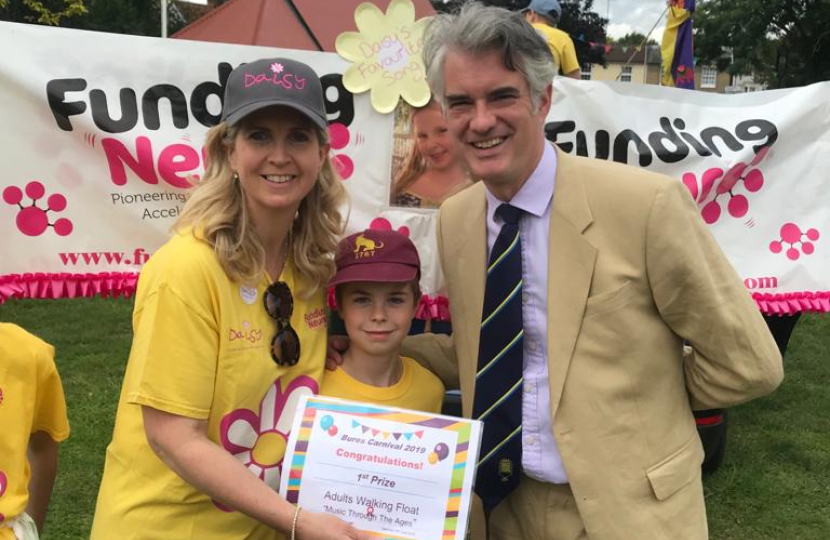
James with Anna Brooks in 2019.
The legacy of a Suffolk schoolgirl – who lost her battle with a rare brain tumour at the age of seven – has been hailed for helping enable a potential breakthrough cure.
Potential treatments for diffuse intrinsic pontine glioma (DIPG), a rare brain cancer, are ready to advance to the clinical trial stage, following new research into the disease.
South Suffolk MP James Cartlidge confirmed this week he had written to the Medicines and Healthcare Regulatory Agency (MHRA), urging it to review the trial as soon as possible, so it can begin at Great Ormond Street Hospital.
He paid tribute to the campaigning and fundraising of Bures parents Anna and Louis Brooks, in memory of their daughter Daisy, to help the research go ahead.
Daisy Brooks received an experimental treatment for DIPG at Bristol Children’s Hospital in 2014, two months after her family was rocked by the diagnosis.
Although it was not enough to save her, Anna and Louis have since raised hundreds of thousands of pounds to help fund further research, including the latest study at Great Ormond Street.
Mr Cartlidge welcomed the potential breakthrough treatment, adding: “It provides hope to all those families that have been affected by DIPG and those who may, sadly, face it in the future.
“Many people know of the story of Daisy Brooks and the affect DIPG has had on the family.
“I hope the MHRA builds on the research and studies that have been conducted in the US to help those children in need.
“Brain tumours are the most common cause of cancer-related death in children so this potential breakthrough is vital.”
DIPG is a rare, highly-aggressive type of brain tumour, which occurs in an area of the brain stem that controls many of the body’s most vital functions.
When former Bures Primary School pupil Daisy was diagnosed with DIPG in May 2014, doctors stated there was no hope of a cure.
Her mum and dad then scoured the globe for treatment options, before discovering a pioneering treatment in Bristol, which Daisy underwent in June that year, becoming the first child to do so.
She died on November 17, 2014 – one day after celebrating her seventh birthday.
Anna and Louis have stated they were shocked by the lack of research into DIPG, and have spent the last eight years raising awareness and funds to pursue new treatments for the disease.
Their efforts played a key role in financing the new research, along with Funding Neuro and the Great Ormond Street Hospital Children’s Charity.
“We hope that one day, a cure will be found,” they said.
“Daisy’s dignity and bravery has helped to pave the way in pioneering a cure for DIPG.
“We will not stop raising awareness of this condition, or funds, to help find that cure to help the children and families so unfairly affected by this cruel illness.
“We’re very pleased these trials will now take place and, hopefully, no more families will have to suffer the loss of a child like we did.”
The new treatment to be trialled seeks to utilise DIPG patients’ own immune systems to engineer CAR T-cells, to recognise and eradicate the cancerous cells, improving their chances of survival.
Mr Cartlidge said he hopes a clinical trial will serve as “a crucial first step in developing effective CAR T-cell treatments for DIPG.
“Daisy’s parents are an example to us all,” he said.
“Research can deliver, if only we can back it. We have heard about the low priority that research into brain tumours receives.
“My view is that I am a parent of four children, the oldest of whom is nine, but I cannot even begin to imagine what it is like to have a child, who is so vulnerable already, in the position that Daisy was in.
“Whenever a child is ill, we feel incredibly powerless, but we are not powerless and nor is the Government.
“We have the power to raise the priority of brain tumour research and I hope the Government do so, in memory of those who have suffered so tragically and so that we can deliver hope to those who, unfortunately, will suffer in the future.”
Published by the Suffolk Free Press.

